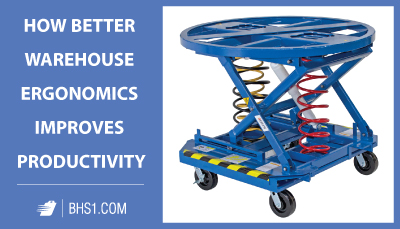We use cookies to make your experience better. To comply with the new e-Privacy directive, we need to ask for your consent to set the cookies. Learn more.
How Better Warehouse Ergonomics Improves Productivity
In the not-so-distant past, managers viewed warehouse ergonomics as mostly a matter of worker comfort—it was a nice thing to provide, but not a necessity. And while comfort is certainly one element of ergonomics, it is just one of many benefits of safer and more efficient processes. A more essential and frequently overlooked advantage to good ergonomics is improved productivity.
Better ergonomics equals less bottlenecking.
To those who have studied warehouse operations, there is a definite relationship between poor ergonomics and bottlenecks in processes. Jim Galante, chairman of the Ergonomic Assist Systems and Equipment (EASE) Council, talked to Modern Materials Handling about how removing bottlenecks frequently requires ergonomic solutions.
"You almost can’t have one without the other since wasted motion, energy, or some wasted resource is the root cause," Galante says. "It’s clear that lean methodologies and ergonomics are tied very closely."
To put it another way, using a pallet carousel to speed up packing or unloading achieves two goals at once. By reducing bending and reaching, the rotating lift table makes work easier for the worker. Injuries and straining are less likely as a result of positioning the load closer to the body at a more comfortable height.
By making the task less physically stressful on the worker, the process speeds up. There is less wasted motion and energy, meaning work gets done faster and more efficiently. Removing the bottleneck improves ergonomics and vice versa.
An aging workforce makes ergonomics even more important.
The Bureau of Labor Statistics reports that the American workforce is getting older. Better health and longer lives partially fuel this trend, but older workers still require special attention in regards to strenuous activity. The good news is that employers who accommodate older workers can see big benefits.

For instance, BMW asked for input from their aging staff about how to create a more physically comfortable work environment. After implementing 70 small changes, such as providing orthopedic footwear, using angled monitors, and buying hoisting cranes, the luxury car maker saw a 7 percent productivity increase in one year.
At the same time, the staff was happier and felt respected because management invested in their well-being. Management benefitted from the increase in productivity and staff benefitted from a safe and healthy work environment.
Better ergonomics require observation and input.
Two good ways to identify areas for improvement are to locate bottlenecks and seek employee involvement. As we discussed above, the solutions for bottlenecks, like assistive lifting devices or rotating staff out of jobs with repetitive motions, are generally ergonomic ones.
Seeking staff input is just as important as observing an operation's procedures. Employees will often have input that can improve processes due to experiencing the problems firsthand. Frequent and candid communication between managers and employees provides a shortcut to solving problems.
The Occupational Safety and Health Administration (OSHA) provides further resources for how businesses can improve ergonomics by observing workplace conditions and encouraging communication. Tips from OSHA include:
-
Train workers how to properly lift, when to use material-handling equipment, and how to recognize early signs of musculoskeletal problems.
-
Learn from past injuries. Review injury and illness logs and other records to locate problem areas for improvement.
-
Encourage workers to report injuries—early reporting can catch injuries before they are severe, allow prompt medical intervention, and guide job modification.
Improving ergonomics is an ongoing process. As new information and equipment becomes available, operations must be willing to embrace change to stay competitive. After all, keeping staff healthy and happy isn't just good for morale, it's also good for business.
References:
Bond, Josh. "Ergonomics: take comfort in productivity." MMH. Peerless Media LLC, 1 May 2016. Web. 7 Sept. 2017.
Druley Kevin. "Keeping aging workers safe." SafetyandHealthMagazine. National Safety Council, 20 Dec. 2016. Web. 7 Sept. 2017.
"Ergonomics." OSHA. Occupational Safety and Health Administration. U.S. Department of Labor, n.d. Web. 7 Sept. 2017.
Toossi, Mitra and Elka Torpey. "Older workers: Labor force trends and career options." BLS. Bureau of Labor Statistics, U.S. Department of Labor, May 2017. Web. 7 Sept. 2017.
